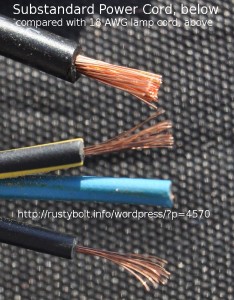 I bought a PATA/SATA to USB adapter that consists of the adapter, an AC power brick and assorted cables, including the power cord from the power brick to the wall outlet. This world standard power cord is just like the ones on PCs, monitors, printers, etc., but it’s short, about a meter long, But the most disturbing thing about it is the substandard wire used, This particular cord is marked 0.5mm2 along its length, but other cords I’ve seen don’t have any markings. This wire is about the equivalent of 24 AWG. It’s tiny compared to a standard lamp cord, shown in the picture. The plug is labeled 10A 250V, implying that the cord itself can handle 10 amps. I cut off the plug and connected the line and neutral wires together (the colors of the wires are also non-standard – ground wire is blue instead of the standard green). I then measurd the resistance of the cord from the wall plug, and got 1.2 ohms. This is many times higher resistance than a power cord using 18 AWG wire.
I bought a PATA/SATA to USB adapter that consists of the adapter, an AC power brick and assorted cables, including the power cord from the power brick to the wall outlet. This world standard power cord is just like the ones on PCs, monitors, printers, etc., but it’s short, about a meter long, But the most disturbing thing about it is the substandard wire used, This particular cord is marked 0.5mm2 along its length, but other cords I’ve seen don’t have any markings. This wire is about the equivalent of 24 AWG. It’s tiny compared to a standard lamp cord, shown in the picture. The plug is labeled 10A 250V, implying that the cord itself can handle 10 amps. I cut off the plug and connected the line and neutral wires together (the colors of the wires are also non-standard – ground wire is blue instead of the standard green). I then measurd the resistance of the cord from the wall plug, and got 1.2 ohms. This is many times higher resistance than a power cord using 18 AWG wire.
Let’s go through a scenario. The user leaves most of the cord bundled up with the wire tie around it. He then plugs it into a power strip and into a high current appliance, such as a big laser printer that draws 10 amps during the time the fuser element gets hot. The power cord’s 1.2 ohm resistance drops 12 volts at 10 amps. Power in watts is V times I, so 12V times 10 amps is 120 watts. What?!?! That means that the power cord will be dissipating so much power that it will overheat and catch fire! REALLY!
I’m not sure why this is being sold in the U.S, because it will not meet the long established electrical and fire standards. Could it be that this is sneaking through the system without being caught? Every American made product such as inexpensive lamps must use a power cord that meets standards.